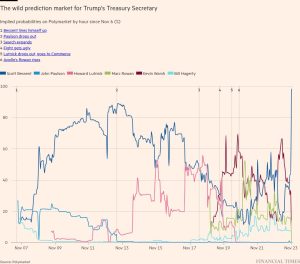UK wage growth falls to 4.9%
Stay informed with free updates
Simply sign up to the UK employment myFT Digest — delivered directly to your inbox.
UK wage growth fell to 4.9 per cent in the three months to August, while growth in payroll employment flattened, official data showed on Tuesday.
Annual earnings growth, excluding bonuses, was in line with analysts’ expectations, and compared with 5.1 per cent in the three months to July, the Office for National Statistics said.
Including bonuses, wage growth was lower at 3.8 per cent, but this figure was skewed by large one-off bonuses to public sector workers last year.
The ONS said tax records showed that payroll employment fell slightly, by 35,000 or 0.1 per cent, in August while provisional figures for September suggested employment was virtually unchanged.
The data adds to evidence that pay pressures in the economy are easing. It also corroborates recent business surveys suggesting many employers have put hiring on hold ahead of this month’s Budget as they await more certainty over government policy on tax and spending.
“Should these labour market trends continue, Britain’s brief era of healthy pay growth could soon end,” said Charlie McCurdy, economist at the Resolution Foundation think-tank.
Wages are still rising faster than inflation, with real terms growth of 1.9 per cent in the three months to August excluding bonuses, and 0.9 per cent including one-off payments.
But Ben Harrison, director of the Work Foundation at Lancaster University, noted that even at the end of “a record 25-month run” of pay growth above 5 per cent, high inflation had left workers only £14 a week better off on average in real terms than two years ago, and £20 better off than in 2008.
The ONS also pointed to an ongoing decline in vacancies, which fell over the past quarter in all industries, leaving the total number of open posts at 841,000 — just above the pre-pandemic level.
Analysts said the figures supported the case for the Bank of England to continue cutting interest rates in November, following its decision in August to reduce the benchmark rate to 5 per cent.
Ashley Webb, at the consultancy Capital Economics, said the data showed private sector pay growth slowing in line with the BoE’s own forecasts, leaving a November rate cut “looking even more likely”.
Policymakers on the Monetary Policy Committee want to see clear evidence that the pay pressures that have been driving service price inflation are easing before they cut interest rates again.
Huw Pill, the BoE’s chief economist, said earlier this month there was “ample reason” for caution to avoid cutting borrowing costs too far or too fast.
Tracking the true state of the UK labour market has been especially difficult for rate-setters because ongoing problems with the ONS’s labour force survey mean its key estimates of employment, unemployment and economic inactivity are unreliable.
Wage figures are based on a different survey, and policymakers have been able to use administrative data — including the payroll records — and non-official surveys to help form a picture of hiring and employment.
The official LFS-based estimates for the three months to August suggest more strength than other sources, showing unemployment falling from 4.1 per cent to 4 per cent in the latest month, with employment strengthening.
However, the ONS said these numbers were at odds with the other sources and should be viewed with caution.
#wage #growth #falls





